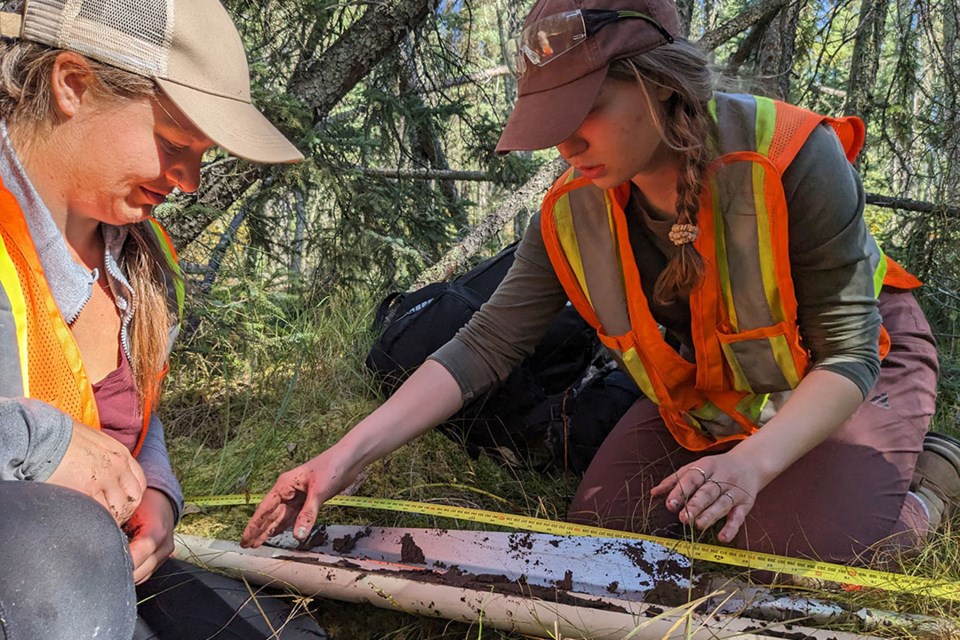SASKATOON — USask and Métis Nation–Saskatchewan (MN–S) have partnered together on a project that involves the environment, the community, experiential learning, and carbon storage data.
The project started with MN–S reaching out to USask to see if it would be interested in taking peat samples from local muskegs (also known as treed wetlands or peatlands) in the Nisbet Community Forest, to see how much carbon was stored there.
“The peat within muskegs stores an incredible amount of carbon, but this carbon sequestration is dependent on the peat being saturated with water,” said MN–S Environment Director Brent Laroque. “As the water table drops the peat begins to decompose, or burn during wildfires, releasing its stored carbon. What happens to these southern examples of muskeg may be the fate of more northern muskegs and so it is critical to establish monitoring procedures quickly.”
MN–S Vice-President and Environment Minister Michelle LeClair agreed carbon storage is an important aspect of this project but said beyond that, “It is a critical ecosystem to the traditional ways of Métis, Cree, and Dene peoples, especially in the north. It is an underappreciated landscape that holds many traditional medicines, provides habitat for many species, and creates fire breaks that prevent wider scale fires. What we learn from this partnership will be invaluable shared knowledge for future generations.”
Hillary Kyplain, the conservation co-ordinator for MN–S, is an alumna of the Renewable Resource Management (RRM) program in the College of Agriculture and Bioresources (AgBio) at USask. She recommended MN–S connect with the college and its RRM program for undergraduate students.
“One of our goals is to build capacity across MN–S and collaborate with non-governmental organizations, universities, and other Indigenous organizations to identify partners interested in advancing wetland conservation by providing technical and research capacity,” said Kyplain.
Collaborating with Dr. Bryan Mood (PhD), Renewable Resource Management program co-ordinator and lecturer for AgBio, a strategy was developed to obtain peat samples while providing experiential learning for students.
The sample peatlands were identified with help from MN–S Elders Ben and Debbie Smith in summer 2023.
In September 2023, USask students majoring in , conducted sampling in the selected peatlands. High school students from Stobart Community School in Duck Lake, Sask., joined the USask students for a day of experiential learning.
“There is nothing better or more tangible that getting out of the classroom and seeing what you’ve been learning about,” said Mood.
The students received hands-on learning experience by conducting peat sampling using a peat corer. The students also learned from Laroque and Mood about wetland plant communities, traditional herbs and medicines, and the importance of peat and how it is formed.
“Experiential learning, especially field-based courses, can help develop a more realistic and tangible understanding of how everything interacts together in the environment,” said Mood. “Students can achieve an appreciation and understanding of different concepts beyond its description in a textbook.”
“The high school students were able to get a better understanding of what a career in the renewable resource management field could look like,” said Laroque. “I believe that exposure for Indigenous students to STEM careers in a comfortable space that seeks to ‘meet them where they are’ in non-institutional settings and with practical exercises is critical to creating greater engagement and understanding in the value of exploring these types of careers.”
After the students collected the peat samples, the carbon in the samples was measured using the USask Department of Soil Science’s new soil carbon analyzer, Elementar soli TOC® cube. In February 2024, the USask students presented the results of the research to MN–S and community members.
“The research showed that there is a significant amount of carbon being stored in the muskeg, which was similar to plant matter ranging from 30-40 per cent,” said Mood. “This is higher than expected and significantly more than what we see from agricultural surface soils which tend to be 1-2 per cent (and much lower in mineral soils).”
These research results are beneficial to both the environment and the community.
“This research gave us valuable insight on where MN–S can go further in terms of monitoring and research that will benefit our carbon modelling goals,” said Kyplain.
“Understanding how much carbon is in the muskeg has a direct impact on the community. Voluntary carbon standards currently exist as an economic incentive to maintain these valuable ecosystems and prevent them from being commercially developed,” said Mood.
With both USask and MN–S working together towards the common goals of environment conservation, climate change mitigation, and experiential learning, an exchange of unique ideas and perspectives happened that wouldn’t have been possible with just one party working on the project.
“The collaboration has been a great success and I believe it has had positive outcomes for everyone involved, said Laroque. “The openness of USask staff in working alongside the Métis Nation has been greatly appreciated.”
— Submitted by USask Media Relations




